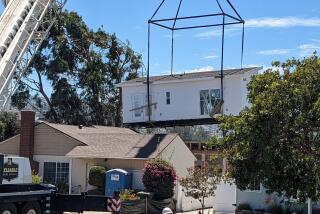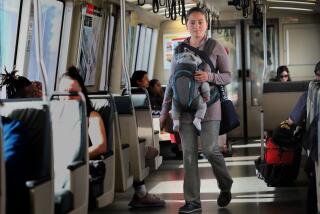S.D. to Get First Bank Under New U.S. Charter Law : Finance: Legislation is designed to bring services to inner-city areas. Oakland is the next likely site.
SAN DIEGO — A local neighborhood with few banks has been identified as the first to get a nationally chartered bank under a new federal law designed to bring financial services to inner cities.
A dozen or more communities nationwide, including Oakland, are expected to be sites of newly chartered inner-city banks this year, banking officials said. Nothing is yet in the works for Los Angeles.
San Diego-based Neighborhood Development Bank last week became the first to receive a national charter under the law and will offer low-income mortgage, business, housing development and consumer loans at a branch to open over the next month or so in Southeast San Diego.
The approach is billed as an innovative step that the Clinton Administration hopes will help gradually increase banking services in areas with high poverty levels. The charter was awarded by the Office of the Comptroller of the Currency under the Community Development Financial Institutions Act passed last year.
Congress budgeted $100 million this year to help capitalize so-called community development banks under CDFI guidelines. The new banks are to be modeled after Southshore Bank of Chicago and Community Capital Bank in Brooklyn, N.Y., two prototypes that have successfully provided financial services in depressed areas neglected by conventional banks.
The next such bank expected in California is the Community Bank of the Bay in Oakland, said Robert A. McNeely, an executive at Union Bank, the lead bank investor in the San Diego venture, and board chairman of Los Angeles Community Reinvestment Committee Inc.
“Symbolically, it means that new capital is coming into an area that has perhaps been deprived of bank services in the past,” McNeely said.
Projected to grow to $50 million in assets over the next three years, the San Diego bank won’t approach the size or significance of Great American Bank, HomeFed Bank or Imperial Savings, three local thrifts that each had several billion dollars in assets before crashing during the savings and loan debacle.
About 75% of Neighborhood Development Bank’s loans will be low-income mortgages and development loans, and 20% will be made to businesses run by minorities and women. The remaining 5% will be consumer loans.
“Our focus is economic development, job creation and affordable housing in an underserved area of San Diego,” said the new bank’s chief executive, Robert M. McGill.
He said the new bank will be in a neighborhood with few bank branches.
McGill, 50, a former senior vice president of the Federal Reserve Bank of Los Angeles, said he has been trying to get the bank off the ground for three years. Neighborhood Development Bank has received equity investment totaling $8 million from Union Bank, Wells Fargo and Manufacturers Bank, among others. The federal government will also make an investment under guidelines of the CDFI.
The Clinton Administration has been leaning on major banks to increase their lending activity in low-income areas and now sees their investment in CDFI-chartered banks as one way of doing that.
“For us, this investment in Neighborhood Development Bank is another form of our community support,” said Union Bank’s McNeely.
“We hope it will help,” said Quinta Seward of Communities for Accountable Reinvestment, a Los Angeles-based grass-roots activist group that seeks more financial services for low-income neighborhoods. “We do know that if banks just make more loans and open up branches in areas where they are needed, the business will come. But so far, very few banks have.”
No community bank is close to formation in Los Angeles, sources said, partly because three private, minority-owned institutions--Founders National Bank, Broadway Savings and Family Savings--all serve Los Angeles’ inner city. A federally subsidized community bank is seen as potentially unfair competition for the existing banks.
More to Read
Sign up for Essential California
The most important California stories and recommendations in your inbox every morning.
You may occasionally receive promotional content from the Los Angeles Times.










